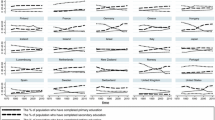Abstract
This study aims to empirically investigate the dynamics of relationship among human capital formation, self-employment (SE), and economic growth in Pakistan. Using quarterly data of primary school enrollment, SE, and GDP per capita, we employed ARDL bound testing approach to cointegration covering the time span of 1995–2010. We found that in the long run, primary school enrollment, high school enrollment and SE have significant impact on economic growth. Enrollment in primary schools (EP) has a strong positive and significant impact on economic growth, whereas enrollment in high school has a relatively small positive and significant impact on economic growth in the long run in Pakistan. Further, SE has a small, positive and significant impact on economic growth in the long run. In short run, enrollments in high schools and SE have weak positive impact on economic growth whereas, EP has a strong positive and significant impact on economic growth in Pakistan. Further it is found that that there is unidirectional long run causality from self employment to economic growth followed by the bidirectional short run causality between economic growth and high school enrollment, GDP per capita and primary school enrollment, high school enrollment and primary school enrollment.



Similar content being viewed by others
References
Acs, Z.J., Audretsch, D.B.: Innovation and Small Firms. MIT Press, Cambridge (1990)
Audretsch, D.B., Feldman, M.P.: R &D spillovers and the geography of innovation and production. Am. Econ. Rev. 86(3), 630–640 (1996)
Audretsch, D.B., Stephan, P.E.: Company–scientist locational links: the case of biotechnology. Am. Econ. Rev. 86(3), 641–652 (1996)
Barro, R.J.: Human capital and growth. Am. Econ. Rev. 91(2), 12–17 (2001)
Barro, R.J., Lee, J.W.: International comparisons of educational attainment. J. Monet. Econ. 32(3), 363–394 (1993)
Bashir, S., Gebremedhin, T., Fletcher, J.J.: An Analysis of the role of self-employment in the economic development of the rural northeastern United States. Presented at the Mid-Continent Regional Science Association Annual Meeting, June, 2011, Detroit, MI (2011)
Becker, G.S.: Investment in human capital: a theoretical analysis. J. Political Econ. 70(Supplement), 9–49 (1962)
Bhargawa, A.: On the theory of testing for unit roots in observed time series. Rev. Econ. Stud. 53, 36–84 (1986)
Blundell, R., Dearden, L., Meghir, C., Sianesi, B.: Human capital investment: the returns from education and training to the individual, the firm, and the economy. Fiscal Stud. 20(1), 1–23 (1999)
Bosworth, B., Collins, S.M., Chen, Y. C.: Accounting for differences in economic growth. Brookings Institution Working Paper (1995)
Caves, R.E.: Industrial organization and new findings on the turnover and mobility of firms. J. Econ. Lit. 36(4), 1947–1982 (1998)
Cohen, W.M., Daniel, A.L.: Innovation and learning: the two faces of R &D. Econ. J. 99(397), 569–596 (1989)
Elu, J.: Human development in sub-Saharan Africa: analysis and prospects for the future. J. Third World Stud. 17(2), 53–71 (2000)
Gundlach, E.: Human capital and economic development: a macroeconomic assessment. Kieler Arbeitspapiere, No. 778 (1996). http://hdl.handle.net/10419/920
Heyneman, P.: Education in sub-Saharan Africa: Serious problems, significant opportunities. Report Presented at the African Summit Conference, Houston, TX, 24 April 1999
Jacobs, J., Kroonenberg, S., Wansbeek, T.: Dividing by 4 an efficient algorithm for the optimal disaggregation of annual data into quarterly data (1992). http://www.eco.rug.nl/medewerk/JACOBS/jjdownload/graytex.pdf
Keller, K.R.I.: Investment in primary, secondary and higher education and the effects on economic growth. Contemp. Econ. Policy 24(1), 18–34 (2006)
Lahari, W., Haug, A.A., Garces-Ozanne, A.: Estimating quarterly GDP Data for the South Pacific Island Nations. Economics Discussion Papers no. 0805. University of Otago (2008)
Lee, K., Kim, B.: Both institutions and policies matter but differently at different income groups of countries: determinants of long-run economic growth revisited. World Dev. 37(3), 533–549 (2009)
Lucas, R.E.J.: On the mechanic of economic development. J. Monet. Econ. 22, 4–42 (1988)
Mankiw, N.G., Romer, D., Weil, D.N.: A contribution to the empirics of economic growth. Q. J. Econ. 107(2), 407–437 (1992)
Mazumdar, K.: Causal flow between human well-being and per capita real gross domestic product. Soc. Indic. Res. 50, 297–313 (2000)
Mincer, J.: Investment in human capital and personal income distribution. J. Political Econ. 66(4), 281–302 (1958)
Nelson, R.R., Phelps, E.S.: Investment in humans, technological diffusion, and economic growth. Am. Econ. Rev. 56, 69–75 (1966)
Oketch, M.O.: Costing and financing higher education for development in Africa: Kenya’s case. Int. Educ. Electron. J. 3(4), 1–100 (2000)
Oketch, M.O.: Human resource development and Africa’s economic growth: perspectives for policy planning in Kenya. Unpublished Ph.D. dissertation, University of Illinois at Urbana-Champaign (2002)
Pesaran, M.H., Shin, Y., Smith, A.: Bounds testing approach to the analysis of level relationships. J. Appl. Econom. 16, 289–326 (2001)
Petrakis, P.E., Stamakis, D.: Growth and education levels: a comparative analysis. Econ. Educ. Rev. 21, 513–521 (2002)
Pradhan, R.P., Sanyal, G.S.: Good governance and human development: evidence form Indian states. J. Soc. Dev. Sci. 1(1), 1–8 (2011)
Rebelo, S.: Long-run policy analysis and long-run growth. J. Political Econ. 99(3), 500–521 (1991)
Romer, P.M.: Increasing returns and long-run growth. J. Political Econ. 94, 1002–1037 (1986)
Romer, P.M.: Are non-convexities important for understanding growth. Am. Econ. Growth 80, 97–103 (1990)
Schultz, T.W.: Investment in human capital. Am. Econ. Rev. 51, 1–17 (1961)
Shane, S.: A General Theory of Entrepreneurship: The Individual Opportunity Nexus. Edward Elgar, Cheltenham (2004)
Sylwester, K.: Income inequality, education expenditure, and growth. J. Dev. Econ. 63, 379–398 (2000)
Uzawa, H.: Optimal technical change in an aggregate model of economic growth. Int. Econ. Rev. 6, 18–31 (1965)
Author information
Authors and Affiliations
Corresponding author
Rights and permissions
About this article
Cite this article
Rehman, I.U., Mahdzan, N.S.A., Trifu, A. et al. A cointegration approach to modeling human capital formation, self-employment, and economic growth: evidence from Pakistan. Qual Quant 48, 1439–1453 (2014). https://doi.org/10.1007/s11135-013-9845-1
Published:
Issue Date:
DOI: https://doi.org/10.1007/s11135-013-9845-1




